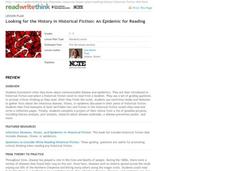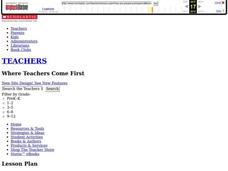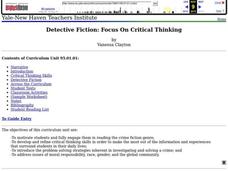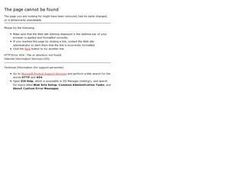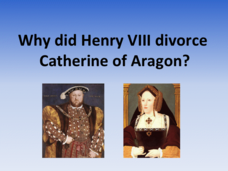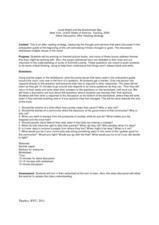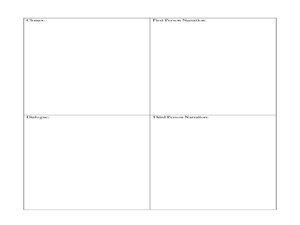Curated OER
Maus: Making a Visual Representation
How do you represent a tragic event? Are stories of tragic events better left untold? After reading chapter two of Maus and studying other representations of the Holocaust (suggestions are included), class members create a representation...
ReadWriteThink
Looking for the History in Historical Fiction: An Epidemic for Reading
Combine informational reading skills with fictional text in an innovative historical fiction lessons. After reading a fictional text related to diseases, class members read non-fictional text to gain knowledge about specific infectious...
Curated OER
How are People Portrayed by Different Media?
Your 9th - 12th graders can hone their analysis and critical thinking skills by studying the way a subject is portrayed across media types. They examine how various print, visual, and online sources have portrayed key players in the 9/11...
Curated OER
Ready-Set-Go-Whoa!
The Apaches: People of the Southwest offers readers a chance to employ the “Ready-Set-Go-Whoa!” strategy (an adaptation of the KWL) to test what they know and summarize what they learn as they read Jennifer Fleischner’s nonfiction...
Curated OER
Lesson: Extra! Extra! Read All About It!
A great idea for a fun homework assignment! The class fully and critically analyzes Daniel Sprick's painting, Your Plans. They then generate questions to ask the artist as they attend a mock press conference. They pretend to ask the...
Curated OER
Fast Food Nation: Study Questions
Are you introducing your class to the horrors of eating unhealthy? This lesson contains 24 reading comprehension questions relating to the non-fiction book. Readers are encouraged to copy these and answer them in their reading...
Student Handouts
Logical Fallacies
Help your learners grow their critical thinking and analytical skills by asking them to examine logical fallacies. After reading an example, pupils determine if two sets of premises and conclusions are logical fallacies or not and...
Curated OER
Critical Reading, Imaginative Writing and the Montage
Students discuss the difference between primary and secondary sources and consider how an exhibit is researched. They design and create a montage that reflects themselves in a social and historical context.
Curated OER
Hoot Chapter Book Test
If you need a quick reading assessment for Carl Hiaasen's Hoot, use these 20 questions to see how well your learners comprehend the story. The final question prompts kids to write a short essay about the story's environmental...
Curated OER
Critic's Corner
Students role-play the role of book critics in their classroom. Individually, they write an evaluation on each book they reading along with a book review. In groups, they examine a variety of professional book reviews and share their...
Curated OER
A Critical Role
Students read a New York Times review of the Museum of the African Diaspora in San Francisco. They discuss the roles and responsibilities of a cultural critic, and prepare for a visit to a local museum in order to write their own reviews.
Curated OER
The Lion and the Mouse
Students write a story. In this critical thinking and writing lesson, students read a fable, answer the provided thinking skills questions, and write their own fable.
Curated OER
Writing with Writers
Students participate in Writing with Writer's, a step-by-step set of directions aimed at improving different genres of student writing. They identify the characteristics of different genres and follow a specified writing process to...
Curated OER
Detective Fiction: Focus On Critical Thinking
Turn your 6th graders into detectives while growing their love of reading. Using critical thinking skills, they will be able to describe the five basic elements of detective fiction, read detective novels, make predictions, use the...
Curated OER
Reading Primary Source Documents: Historical Content
Why do we read primary source documents? What can they give us that other writings cannot? Provide your learners with any of the primary sources attached here (there are seven), and have them complete the graphic organizer (which opens...
Curated OER
After I Read Strategy Sheet
After readers finish the story Deep-Sea Monster, they utilize this two-page worksheet to write short-answer responses to questions about the story. The questions posed require critical thinking, not simply recalling details from the...
Curated OER
Why Did King Henry VIII Divorce Catherine of Aragon?
Why did King Henry divorce Catherine of Aragon, and how did he make divorce possible? Young historians will read through each informational slide to learn the story of Catherine of Aragon, King Henry, and Anne Boleyn. They will then...
Curated OER
Nov. 2, 1976 | Carter Defeats Ford in Presidential Election
After reading about the presidential race in 1976, learners think critically about presidential legacy. They read all of the provided background information, related New York Times articles, and then respond to a writing prompt via blog...
Curated OER
Aztec Myths: Writing Editorials
Middle schoolers write an editorial giving an opinion of whether or not Quetzalcoatl has arrived and if so, what the Aztecs should do. They discuss whether or not they believe Quetzalcoatl is a god or a man, and use an Editorial...
Brigham Young University
Silent Discussion: After Reading Strategy for Lizzie Bright and the Buckminster Boy
Complete this after-reading activity for the novel Lizzie Bright and the Buckminster Boy in order to explore the books themes of societal prejudice, peer pressure, authority, and bullying. Write the seven provided questions on...
Curated OER
Lesson Plan: How Coyote Came to Shuffle Off to Buffalo
Creative kids read, discuss, play-act, and sketch to examine the cultural significance of Old Man Coyote. They listen to several stories involving Coyote, analyze the Harry Fonseca painting Shuffle Off to Buffalo, and write Coyote...
Curated OER
Writing a Book Review
Introduce literary analysis, writing skills, and purposeful reading with a book review. Pupils answer five questions that ask about plot, characters, language used, story elements, and the main character. This is a wonderful way to start...
Curated OER
Illustrating the Elements of a Story
Explore the elements of a story with this two-page graphic organizer. Readers write and draw descriptions of each element, including setting, plot, conflict, rising action, climax, dialogue, and narration.
Curated OER
When Is It O.K. to Replace Human Limbs With Technology?
Today's blog topic is robotic limb replacement for amputees. Upper graders read the related article and argument, then compose a blog response that addresses the questions provided. This is a great way to get kids thinking about ethics,...

